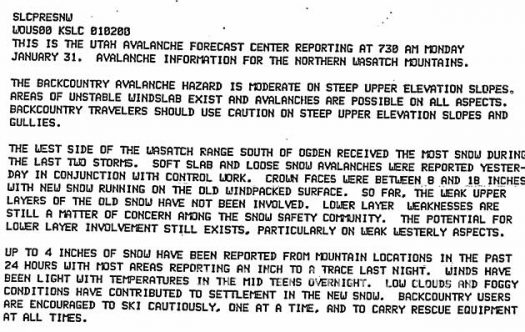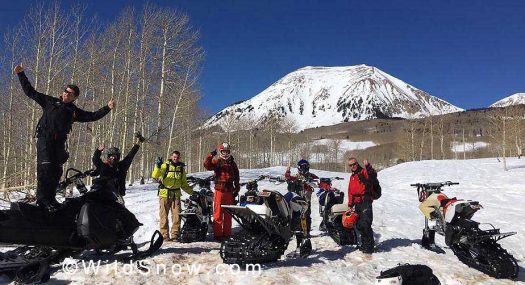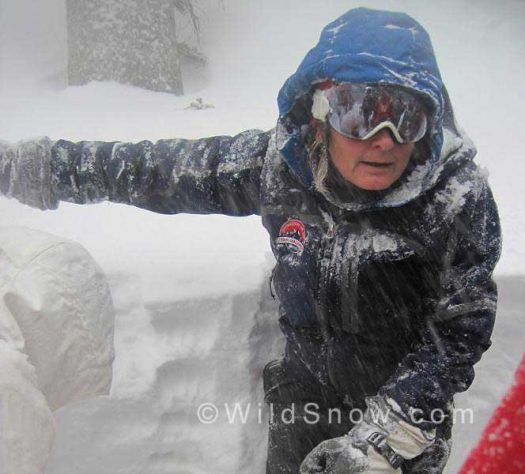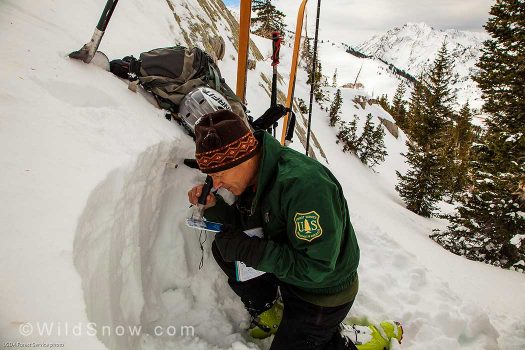Paul Diegel
The Executive Director position of the Utah Avalanche Center is open and applications are being taken. If this is your ultimate dream job, and for an understanding of what goes into compiling the daily avalanche forecast, read on.
For most backcountry skiers and snowboarders in the Wasatch, every morning begins with reading a line like “Issued by Evelyn Lees for Friday, January 15, 2016 – 7:01 AM” and the avalanche and mountain weather advisory that follows. But what does it take to deliver that message? What goes on behind the scenes?

In 1980, if you wanted an avalanche forecast from the Utah Avalanche Center, this is what you got. But in 1980, you couldn’t read the typed script — it was recorded to a phone hot line. And if more than a few people called in at once, you would have to dial the number again later (dialing?).
Operating an avalanche center in the 1980s consisted of scanning National Weather Service data, digging field pits, getting occasional phoned observations of snow conditions, summarizing what was going on, and getting up early every morning to record the phone hotline. The message was generally delivered to a small, homogeneous group and it was unusual to encounter someone unfamiliar on a skin track during a field day.
Fast forward to 2016: The Utah Avalanche Center is one of 18 avalanche centers around the US and has 9 forecasters in 5 offices around the state.
UAC talks to snow safety professionals and traditional media outlets across the state to get and distribute snow information. The general public and a network of observers send in dozens of field observations. We use our phones to access weather station data and models in the field and when friends pester us for information at social events. Forecasters are in the field daily, examining conditions and often posting updates, photos, and videos from behind a tree or in a snowpit for momentary shelter from the wind. We deliver 200 Know Before You Go presentations per year and teach classes to 500 students.
The mission of the Utah Avalanche Center is to keep people on top of the Greatest Snow on Earth. But our biggest challenge isn’t the wind, rising temperatures, or persistent buried weak layers. Our biggest challenge is getting this information to everyone who might need it: skiers, snowboarders, sidecounty riders, snowmobilers, snowshoers, hikers, runners, fat tire bikers, boy scouts, and more, many of whom don’t consider themselves backcountry users. Once they get the information, users need to know how to use it to make wise decisions.
To help our users make wise decisions in complicated conditions, we teach classes, tell stories, issue specific travel advice, work with the media, procudes videos of field conditions — everything possible to help backcountry users make evidence-based decisions and avoid heuristic traps.
UAC provides different products and messages on different channels to target different user groups. Some examples of these specialty products and messages are:

Part of the job involves figuring out new ways people are accessing avalanche terrain and how to meet their needs
We are making a difference, along with a number of other factors like improvements in safety equipment.
The effectiveness of avalanche centers has been boosted by innovative partnerships. In Utah, as in most centers, non-profit organizations (often referred to as Friends groups) and the Forest Service (or state government in Colorado) collaborate to provide avalanche forecasts and education. This structure combines the strengths of public and private sector organizations and mitigates the disadvantages of each.
The Forest Service provides professional forecasters to produce and communicate the daily avalanche and mountain weather advisories, the backbone of the program in Utah.
Non-profit groups provide education and awareness for users from beginners to pros, a website, social media presence, forecasting equipment, and a connection to snowsports brands, along with raising 2/3 of the money required to operate the entire operation.
Donations, grants, event and program income, and business sponsorship combine to create that revenue.
The backcountry growth referred to above suggests that the $800k spent by the Utah Avalanche Center last year may have helped save between 41 and 236 lives in Utah.
Regional avalanche centers provide the information backcountry users need to get into the snow, find the best conditions, and come home safe. Without avalanche forecasts and education, the backcountry would be a lot less fun and a lot more dangerous. Utah Avalanche Center’s message to backcountry users: Get out. Get after it. Make good decisions. Tell us what you see out there. Support your local avalanche center. And make it a great winter.
(Guest blogger Paul Diegel is a recovering engineer with 30 years of experience developing medical devices, aerospace technology, and start-up businesses. He began skiing in Oregon as a child, discovered the Utah backcountry when backcountry skis were approaching 100mm wide (both skis combined) and, in a remarkably pain-free and socially-acceptable mid-life crisis, became the Executive Director of the Utah Avalanche Center in 2007. He is planning to retire at the end of this winter and encourages anyone interested in using their backcountry, communication, and business skills to help keep people on top of the Greatest Snow on Earth — and the ability to slip out on powder days — to consider applying for the Executive Director position.)
Beyond our regular guest bloggers who have their own profiles, some of our one-timers end up being categorized under this generic profile. Once they do a few posts, we build a category. In any case, we sure appreciate ALL the WildSnow guest bloggers!


